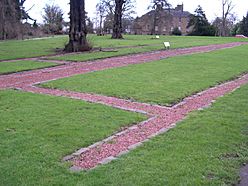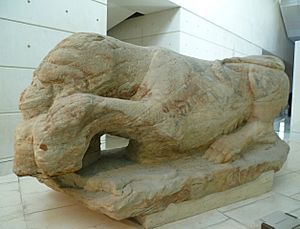Cramond Roman Fort facts for kids
Quick facts for kids Cramond Roman Fort |
|
|---|---|

Site of the Roman fort at Cramond
|
|
| Alternative name(s) | Carumabo?, Rumabo? |
| Founded | c. 140 AD |
| Abandoned | 4th century AD |
| Attested by | Ravenna Cosmography? |
| Stationed military units | |
| — Legions — | |
| vexill. II Augusta | |
| — Cohorts — | |
|
|
| Location | |
| Coordinates | 55°58′39″N 3°17′48″W / 55.9774°N 3.2967°W |
| Town | Edinburgh |
| Country | Scotland |
| Reference | |
| UK-OSNG reference | NT1976 |
Cramond Roman Fort is an old Roman army base in Cramond, Edinburgh, Scotland. It's an important place for archaeologists. Some people think it might be the "Rumabo" mentioned in an old book from the 600s called the Ravenna Cosmography.
The fort was first built around 140 AD. Roman soldiers lived there until about 170 AD. They came back later, from about 208 to 214 AD. Many cool things have been found here, like the famous Cramond Lioness sculpture.
Contents
History of Cramond Fort
The Roman fort at Cramond was built in a smart spot. It was right where the River Almond meets the Forth. This area probably had a natural harbour in Roman times.
Historians think Cramond was part of a line of Roman forts. These forts helped protect the Roman Empire in Scotland. Other forts in this line included Carriden and Inveresk.
Building the Fort and Roman Retreats
The fort was set up around 140 AD. This was when the Romans were building the Antonine Wall further north. Cramond Fort was used until about 170 AD. At that time, the Romans moved their soldiers back south to Hadrian's Wall.
Later, a Roman Emperor named Septimius Severus led a big army into Scotland. This was from 205 to 214 AD. During this time, Cramond Fort was used again and made bigger.
Life Around the Fort
Even when the Roman soldiers were there, people who were not soldiers lived nearby. This was a civilian settlement outside the fort walls. After the Romans left for good, local people might have continued to live in the fort area. This happened into the 300s and 400s AD.
Archaeologists have found several Roman inscriptions at Cramond. These are like messages carved into stone. They tell us more about the people who lived there.
Amazing Discoveries at Cramond
Many interesting objects have been found at Cramond. These discoveries help us understand what life was like for the Romans.
Altars and Inscriptions
One important find is a stone altar. It was found many years ago near Cramond House. This altar was set up by a group of Roman soldiers called Tungrians. They were from a place called Tungria.
The altar was dedicated to "the Alatervan Mothers and the Mothers of the Parade-ground." Some early researchers thought "Alaterva" was the Roman name for Cramond. But now, experts believe "Alatervae" was a special name for certain goddesses. This was a common practice in the Roman Empire. It is now thought that Cramond might have been called "Rumabo" by the Romans. The original name might have been "Carumabo."
Other stones found include a stone from the Legio II Augusta. This stone showed where a group of soldiers built something. Another altar was found that was dedicated to Jupiter Optimus Maximus. This means "Jupiter, Best and Greatest." It was put there by a group of Gaulish soldiers.
The Cramond Lioness
The most famous discovery from Cramond is the Cramond Lioness. This amazing sculpture was found in 1997. It was pulled out of the mouth of the River Almond.
The sculpture is made of white sandstone that isn't found locally. It shows a lioness eating a man. This sculpture was probably part of a large tomb. It might have belonged to an important Roman officer, like the fort commander.
Cramond Fort Today
Today, you can still visit the site of Cramond Roman Fort. You can see the outlines of some of the buildings. These include the main headquarters, storage buildings for grain, and workshops.
There are signs at the site that explain what archaeologists have found. They also help you imagine what life was like in the Roman fort.
Since the year 2000, there have been plans to make Cramond a bigger tourist spot. These plans include building a visitor centre and a museum. This museum would display many Roman objects found in the area. The famous Cramond Lioness would be one of the main attractions.
Images for kids
-
Forts and Fortlets associated with the Antonine Wall. Cramond is to the east.
See also
 In Spanish: Fuerte Romano de Cramond para niños
In Spanish: Fuerte Romano de Cramond para niños






